
Narayanan V.K., Armstrong D.J. - Causal Mapping for Research in Information Technology (2005)(en)
.pdf
90 Diesner and Carley
The resulting networks can be analyzed at varying levels during step 5, graph and analyze data. For example, the analyst might be interested in seeing and analyzing the networks of the text-level concepts that represent all or only some of the meta-matrix categories. We implemented this functionality as sub-matrix text analysis. Each cell in Table 3 denotes a sub-matrix. Sub-matrix analysis distills one or several sub-networks from the meta-matrix and presents text-level concepts in the chosen entity classes. This routine enables a more thorough analysis of particular sections of the meta-matrix, such as Agent-by-Agent networks (social networks), or Organization-by-Resource networks (organizational capability networks). When performing sub-matrix text analysis, AutoMap links the concepts representing the meta-matrix entity classes selected by the analyst into networks.
With the implementation of meta-matrix text analysis and sub-matrix text analysis in AutoMap, we hope to contribute to the investigation of the network structure of social and organizational systems that are represented in texts. With these techniques we aim to provide a reasonable extension of the base technology of computer-supported network text analysis and a practical implementation of the meta-matrix model. In the next section we demonstrate how these novel techniques can help analysts to detect the meaning and underlying social structure inherent in textual data in order to answer related research questions.
Illustrative Example of the Application
of Network Text Analysis
To demonstrate the meta-matrix approach to NTA we use a small sample data set of 18 texts. Each text will be coded using the proposed approach and the AutoMap software.
Data
This text sample is a sub-sample drawn from a larger text collection that consists of 191 texts collected at CASOS about six major terrorist groups that operate in the West Bank. These groups are the Al Aksa Martyrs Brigades, Al Fatah, Al Qaeda, Hamas, Hezbollah, and the Islamic Jihad. We gathered the texts from LexisNexis Academia via exact matching Boolean keyword search for each of the groups. The media that we searched with LexisNexis were The Economist, The Washington Post, and The New York Times. The time frame of our data set ranges from articles published in 2000 to 2003. We sorted the retrieved texts by relevance, screened the top most texts, and selected up to three texts per organization and year for our dataset. The sub-sample from this corpus that we work with in this chapter consists of one text per terror group from each medium from 2003 (Table 4). This sub sample of 18 texts contains 3,035 unique concepts and 13,141 total concepts. The number of unique concepts considers each concept only once, whereas the number of total concepts also counts repetitions of concepts. The reader should keep in mind that the small size of this data set and the fact that the texts were chosen across groups rather than within groups is likely to lead to more overall concepts and fewer
Copyright © 2005, Idea Group Inc. Copying or distributing in print or electronic forms without written permission of Idea Group Inc. is prohibited.

Revealing Social Structure from Texts 91
relations among them. A discussion of Hamas and Yassin may be unlikely to refer to a discussion about al Qaeda and bin Laden; whereas, it is more likely to refer to Rantissi.
This text set is a suitable illustrative example because the detection of covert networks such as terrorist groups is one application domain for meta-matrix analysis (Carley, Dombrowski, Tsvetovat, Reminga & Kamneva, 2003). Since texts are a widely used source of information about terrorist groups, a technique for pulling networks classified according to the meta-matrix scheme from this type of data is needed. The results of this sample study are neither a valid indication of these terrorist groups nor a formal validation of the method of meta-matrix text analysis, but show what information the analyst can gain from this novel technique.
Data Pre-Processing (Concept Identification)
The quality of the map (or network) extracted from the text can be enhanced by preprocessing the data prior to running the analysis: Text pre-processing condenses the data to the concepts that capture the features of the texts that are relevant to the analyst. This technique is also the first step in the procedure of performing meta-matrix text analysis (see section 4). In a previous publication we have described text pre-processing strategies and results with AutoMap in detail (Diesner & Carley, 2004). As a first preprocessing technique we applied a delete list customized for this dataset1. Deletion removes non-content bearing concepts such as conjunctions and articles from texts (Carley, 1993). This reduces the number of concepts the analyst needs to consider when forming thesauri. Then we stemmed the texts with the AutoMap stemmer, which is based on the Porter Stemmer (Porter, 1980). Stemming detects inflections and derivations of concepts in order to convert each concept into the related morpheme (Jurafsky & Martin, 2000). Stemming simplifies the process of constructing a generalization thesaurus and can often eliminate spelling errors and typos. Then we used AutoMap’s Named-Entity Recognition functionality. Named-Entity Recognition retrieves concepts such as proper names, numerals, and abbreviations contained in a text set (Magnini, Negri, Prevete & Tanev, 2002). This technique helps to index agents, organizations, places, and events and facilitates building the meta-matrix thesaurus. There were 591 named entities in our dataset. This list of named entities was used to:
1.Translate relevant phrases into a unit that will be recognized as a single concept. This can be realized in the generalization thesaurus in AutoMap by, e.g., replacing the spaces by words that are separated with underscores.
Table 4. Dataset — number of texts that terror group appears in
Source |
Aksa |
Fatah |
Hamas |
Hezbollah |
Islamic |
al Qaeda |
|
|
|
|
|
Jihad |
|
The Washington Post |
2 |
1 |
2 |
1 |
1 |
2 |
The New York Times |
1 |
2 |
3 |
2 |
2 |
1 |
The Economist |
1 |
2 |
4 |
1 |
2 |
1 |
Total |
4 |
5 |
9 |
4 |
5 |
4 |
Copyright © 2005, Idea Group Inc. Copying or distributing in print or electronic forms without written permission of Idea Group Inc. is prohibited.

92 Diesner and Carley
Examples:
Holi War into Holy_War. The apparent misspelling of Holi results from stemming.
Golan Height into Golan_Heights.
2.Translate people’s names, various versions of their names as they appear in the data set, aliases and synonyms that these people use into the organization that this person is associated with.
Examples:
Dr. Abdel Aziz Rantisi and Dr. Rantisi into Aziz_Al-Rantisi, who is a member of Hamas.
Mahmoud Abba and Abu Mazen into Mahmoud_Abbas, who is a member of the Palestinian Authority.
3.Translate various spellings of a group and synonyms for groups into one unique name of the related group or organization.
Examples:
Hizbullah into Hezbollah.
Islamic Resistance Movement into Hamas.
Thesaurus Creation
The resulting 170 pairs of associations of text-level concepts with higher-level concepts formed a generalization thesaurus. As noted, a generalization thesaurus translates textlevel concepts into higher-level concepts. A single higher-level concept typically has multiple text-level entries associated with it in a thesaurus. For example, Imad Falouji (the higher-level concept), a Hamas member, appeared in the text set as Imad Falouji and Mr. Falouji (two related text-level concepts). The more text-level entries are associated with a higher-level concept, the greater the level of generalization being employed by the analyst.
Since no pre-defined thesaurus was available to us that would have matched terrorismrelated concepts to meta-matrix entity classes, we built a second generalization thesaurus. After applying the generalization thesaurus, we built and applied a second generalization thesaurus with 50 entries that translates people’s names into organizations or more abstract groups with which these people are associated. We used four basic guidelines:
1.Members of the six terrorist groups that the data set focuses on into the related terrorist organization.
Copyright © 2005, Idea Group Inc. Copying or distributing in print or electronic forms without written permission of Idea Group Inc. is prohibited.
Revealing Social Structure from Texts 93
Examples:
Aziz Al-Rantisi into Hamas.
2.Representatives of the governments of various countries into the country’s government.
Examples:
Omar Sulieman into Egypt_Government.
Mahmoud Abbas into Palestinian_Authority.
3.People’s names into organizations or abstract groups that they belong to.
Examples:
Hans_Blix, Kofi_Annan, and Michael_Chandler into UN. Hanadi Jaradat and Saed Hanani into Suicide_Bomber. Haviv_Dodon, Muhammad_Faraj
Samer_Ufi into Victim_Killed.
In doing this, the basic principle we were applying was to retain specific actors — those who appeared to play primary roles, whereas secondary actors were reclassified by their role, such as victim. Not all names of people that can be associated with a group were translated into the related group. We applied this strategy in order to enable us to retranslate the entity class Agent, to which we assigned these names in the meta-matrix thesaurus that we applied after the second generalization thesaurus, into the names of key players relevant to us in a sub-matrix text analysis that can be run after the meta-matrix text analysis. Names that we decided not to match with an organization are for example Osama bin Laden, Yasser Arafat and Ariel Sharon. This level of maintenance of detail of information always depends on the research question or goal. Our goal was to detect the network structure of terrorist groups.
After finishing the generalization process2 we built and employed a meta-matrix thesaurus. In order to support the analyst in matching text-level concepts against meta-matrix categories, AutoMap offers the options to: a) load a list of all unique concepts appearing in the text set into the left most column of the meta-matrix thesaurus or b) save a list of a union of all unique concepts on a directory of the analyst’s choice. In the next step the analyst has to manually go through this list and to decide whether or not to associate each single concept with meta-matrix categories. Our dataset contained 2,083 unique concepts after applying the generalization thesauri. Of these unique concepts, 303 were assigned to a single entity class in the meta-matrix, and 23 of them to two entity classes (Table 5, sum of column one). A total of 1780 of the 2083 unique concepts we did not assigned to any meta-matrix entity class, but they were kept as non-categorized concepts. The creation of a meta-matrix thesaurus is step 3, concept classification, in the procedure of performing meta-matrix text analysis (see section 4).
Copyright © 2005, Idea Group Inc. Copying or distributing in print or electronic forms without written permission of Idea Group Inc. is prohibited.

94 Diesner and Carley
Table 5. Creation and application of meta-matrix thesaurus (sorted by frequency)
Category |
Cumulated sum of |
Cumulated sum of |
Cumulated sum of |
|
assignment of concepts |
appearance of entity |
linkage of concepts |
|
to entity classes in the |
classes in texts after |
associated with meta- |
|
meta-matrix thesaurus |
application of meta- |
matrix entity classes |
|
|
matrix thesaurus |
into statements |
Organization |
48 |
569 |
434 |
Location |
81 |
404 |
404 |
Agent |
54 |
250 |
217 |
Resource |
75 |
261 |
188 |
Task-Event |
27 |
168 |
146 |
Knowledge |
41 |
134 |
128 |
In the next step we applied the meta-matrix thesaurus to the data set3 and ran a meta-matrix text analysis on the pre-processed text set4. This technique forms step 4, perform map analysis, in the procedure of performing meta-matrix text analysis (see section 4).
Characteristics of the Textual Networks
as Meta-Matrices (Graph and Analyze
Results)
In this section, we report the results of the meta-matrix text analysis and sub-matrix text analysis we ran on our data set. This task is step 5 in the procedure of performing metamatrix text analysis. The intent in this section is to illustrate the type of results and graphs possible using the proposed meta-matrix approach to NTA, not to present a comprehensive analysis of terrorist networks. In doing this example, we will analyze: 1) unique and total frequencies of the concepts and statements, 2) unique and total frequencies of the statements that were formed from concepts associated with meta-matrix entity classes, and 3) the distribution of statements formed from meta-matrix entity classes across the data set.
For our analysis we considered the six meta-matrix entity classes in Table 3. Therefore, we have six unique entity level concepts. Considering only concepts that fall into one or more of these categories, we found an average of 99.2 total concepts per text, ranging from 37 to 163. Based on these concepts, on average of 18.9 unique statements (ranging from 8 to 29) and 45.7 total statements (ranging from 12 to 84) were formed per text. Thus, on average, each unique statement appeared 2.4 times per text. Theoretically, each text could contain up to 36 unique statements. The theoretic maximum would be achieved if there existed at least one concept associated with each entity, and at least one concept of each entity formed a statement with at least one concept in each other entity class. The multiple occurrences of unique statements are expressed in the number of total statements.
Copyright © 2005, Idea Group Inc. Copying or distributing in print or electronic forms without written permission of Idea Group Inc. is prohibited.
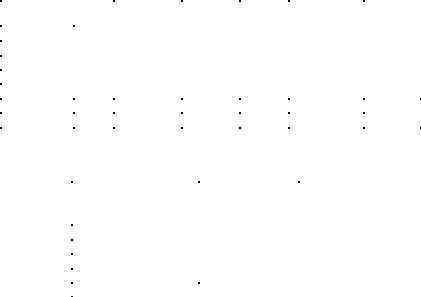
Revealing Social Structure from Texts 95
Across the 18 meta-matrices extracted from our sample texts, 822 total statements were formed within and between the cells of the meta-matrix (see Table 6 for distribution of total statements across meta-matrix). Notice that the upper and lower triangle of the metamatrix in Table 6 are not symmetric. For example, in Table 6 from Resource (row) to Organization (column) there are a total of 23 statements, but from Organization (row) to Resource (column) there are a total of 35 statements. Indeed, there is no need for symmetry as the relations between concepts (edges between nodes) found with AutoMap are directed, which is inherently pre-defined by the directed structure of language. The results in Table 6 show that concepts associated with each meta-matrix entity class appears approximately as often in posterior positions of statements (last row in Table 6) as in anterior positions (last column in Table 6). Thus, the in-degree or receptivity of a meta-matrix entity class approximately equals the out-degree or expansiveness of the class. This is due, in part, to the use of proximity in the text to place links among concepts and reflects, if anything, the lack of overly stylized sentential form.
Within the meta-matrix, the entity class that linked most frequently to other entity classes was Organization (179 links), followed by Location (108), Agent (95), Resource (71), TaskEvent (66), and Knowledge (53). If we do not look at these absolute values, but at percentages of the linkage of meta-matrix entity classes to the same or other entity classes, our results reveal that concepts in the entity class Task-Event are more likely to be connected to concepts in classes other than Task-Event. In contrast to Task-Event, concepts in the entity class Location are most likely to link to other Location concepts (Table 7).
Furthermore, the results indicate that within the networks that we extracted from the texts, most information refers to membership networks (13.8% of all statements, Figure 1).
Table 6. Number of links (total number of statements) between meta-matrix categories
Meta-Matrix |
Agent |
Knowledge |
Resource |
Task- |
Organization |
Location |
Sum |
|
|
|
|
Event |
|
|
|
Agent |
24 |
8 |
8 |
12 |
55 |
12 |
119 |
Knowledge |
10 |
18 |
9 |
3 |
20 |
11 |
71 |
Resource |
8 |
9 |
39 |
11 |
23 |
20 |
110 |
Task-Event |
13 |
7 |
9 |
10 |
20 |
17 |
76 |
Organization |
58 |
23 |
35 |
19 |
90 |
44 |
269 |
Location |
9 |
10 |
17 |
25 |
47 |
69 |
177 |
Sum |
122 |
75 |
117 |
80 |
255 |
173 |
822 |
Table 7. Linkage of meta-matrix entity classes
Meta-Matrix entity |
With same entity |
With other entity |
class |
class (%) |
classes (%) |
Task-Event |
13 |
87 |
Agent |
20 |
80 |
Knowledge |
25 |
75 |
Organization |
33 |
67 |
Resource |
35 |
65 |
Location |
39 |
61 |
Copyright © 2005, Idea Group Inc. Copying or distributing in print or electronic forms without written permission of Idea Group Inc. is prohibited.
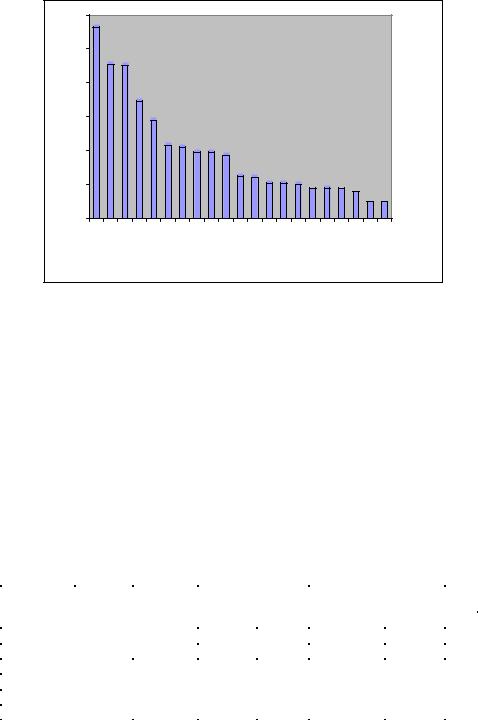
96 Diesner and Carley
Figure 1: Total number of links between meta-matrix categories
|
120 |
113 |
|
|
|
|
|
|
|
|
|
|
|
|
|
|
|
|
|
|
|
|
|
100 |
|
91 |
90 |
|
|
|
|
|
|
|
|
|
|
|
|
|
|
|
|
|
|
stateStatements |
|
|
|
|
|
|
|
|
|
|
|
|
|
|
|
|
|
|
|
|
||
80 |
|
|
|
69 |
|
|
|
|
|
|
|
|
|
|
|
|
|
|
|
|
|
|
|
|
|
|
|
|
|
|
|
|
|
|
|
|
|
|
|
|
|
|
|
||
|
|
|
|
|
|
|
|
|
|
|
|
|
|
|
|
|
|
|
|
|
|
|
of |
60 |
|
|
|
|
58 |
|
|
|
|
|
|
|
|
|
|
|
|
|
|
|
|
Number |
|
|
|
|
|
|
|
|
|
|
|
|
|
|
|
|
|
|
|
|
|
|
40 |
|
|
|
|
|
43 |
42 |
39 |
39 |
37 |
|
|
|
|
|
|
|
|
|
|
|
|
Total |
|
|
|
|
|
|
|
|
|
|
|
|
|
|
|
|
|
|
|
|
||
|
|
|
|
|
|
|
|
|
|
|
|
|
|
|
|
|
|
|
|
|
||
|
|
|
|
|
|
|
|
|
|
|
25 |
24 |
21 |
21 |
20 |
|
|
|
|
|
|
|
|
20 |
|
|
|
|
|
|
|
|
|
|
18 |
18 |
18 |
16 |
|
|
|||||
|
|
|
|
|
|
|
|
|
|
|
|
|
|
|
|
|
|
|||||
|
|
|
|
|
|
|
|
|
|
|
|
|
|
|
|
|
|
|
10 |
10 |
||
|
|
|
|
|
|
|
|
|
|
|
|
|
|
|
|
|
|
|
|
|
||
|
0 |
AO/OA |
OL/LO |
OO |
LL |
RO/OR |
KO/OK |
TL/LT |
RR |
TO/OT |
RL/LR |
AT/TA |
AA |
AL/LA |
KL/LK |
RT/TR |
KK |
KR/RK |
AK/KA |
AR/RA |
KT/TK |
TT |
|
|
Meta-Matrix Cell
Although there is also substantial information on inter-organizational networks (11.1%) and organizational location networks (10.4%). The least information is provided on precedence networks (1.2%) and knowledge requirement networks (1.2%). This suggests that more is known, or at least presented in the news, about who the terrorists are and where they are than about what they do when and what they need to know in order to engage in such actions or why.
The analysis of the distribution of statements formed from meta-matrix entity classes across the text set reveals that all entities are covered in at least one third of the texts. In addition, Organization, Location, and Agent classes appear in more than half of the texts (Table 8). Again, this suggests that more is reported about who and where than about what, how and why. We note that a human reading of these texts may pick up a little more about what and how, although such information does appear to be less common in general in the texts used for this purely illustrative analysis.
Table 8: Number of texts in that links appears
Meta-Matrix |
Agent |
Knowledge |
Resource |
Task- |
Organization |
Location |
Sum |
|
|
|
|
Event |
|
|
|
Agent |
13 |
5 |
6 |
10 |
17 |
9 |
10.0 |
Knowledge |
7 |
9 |
5 |
3 |
9 |
5 |
6.3 |
Resource |
4 |
4 |
9 |
7 |
12 |
11 |
7.8 |
Task-Event |
9 |
3 |
7 |
4 |
11 |
10 |
7.3 |
Organization |
17 |
11 |
13 |
11 |
18 |
16 |
14.3 |
Location |
7 |
7 |
10 |
11 |
17 |
14 |
11.0 |
Sum |
9.5 |
6.5 |
8.3 |
7.7 |
14.0 |
10.8 |
9.5 |
Copyright © 2005, Idea Group Inc. Copying or distributing in print or electronic forms without written permission of Idea Group Inc. is prohibited.
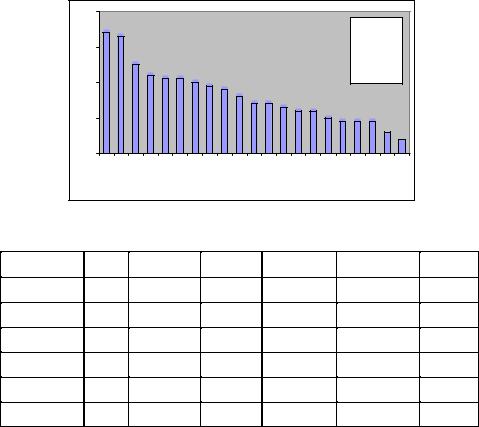
Revealing Social Structure from Texts 97
In Figure 1 and Tables 6 and 8, we have been discussing the total links or statements. Looking at the total links provides information about the overall structure of the discussion and the elements of the structure (agents, knowledge, etc.) that are considered critical by the authors or for which they have a wealth of information. It is often useful to ask about unique links, however, if we want to understand the structure itself. In Figure 2, we display the number of links per sub-matrix that are unique. That is, a link or statement is only counted once regardless of how many texts it appears in.
Comparison of Figures 1 and 2 shows that a great deal of information — particularly in the Agent-to-Agent sub-matrix is repeated across texts. This suggests that either many of the texts were discussing the same information (repetition), or they got their information from the same source. Note that if we knew that each source was unique, then the difference between the total (Figure 1) and the unique (Figure 2) would be an indicator of the reliability of the information.
The overall structure for this covert network is very sparse. In some sense, based on these texts, more is known about the affiliations, locations, resources, and knowledge of agents and organizations than is known about the interrelations of knowledge, resources and tasks (Table 9). Further, if we compare the number of unique links (Table 9) to the number
Figure 2. Number of unique links between meta-matrix categories
|
40 |
|
|
|
|
|
|
|
|
|
|
|
|
|
|
|
|
|
|
|
|
|
34 |
33 |
|
|
|
|
|
|
|
|
|
|
|
|
|
|
|
Legend: |
|
|
|
|
|
|
|
|
|
|
|
|
|
|
|
|
|
|
|
A = Agent |
|
|
|||
|
|
|
|
|
|
|
|
|
|
|
|
|
|
|
|
|
|
|
|||
Statementsstatemen |
30 |
|
|
|
|
|
|
|
|
|
|
|
|
|
|
|
|
K = Knowledge |
|
||
|
|
|
|
|
|
|
|
|
|
|
|
|
|
|
|
R = Resource |
|
||||
|
|
25 |
|
|
|
|
|
|
|
|
|
|
|
|
|
|
T = Task/ Event |
|
|||
|
|
|
22 |
21 |
21 |
|
|
|
|
|
|
|
|
|
|
|
O = Organization |
||||
ofunique |
|
|
|
|
20 |
19 |
|
|
|
|
|
|
|
|
|
L = Location |
|
||||
20 |
|
|
|
|
|
18 |
|
|
|
|
|
|
|
|
|
||||||
|
|
|
|
|
|
|
|
|
|
|
|
|
|
|
|
|
|
||||
|
|
|
|
|
|
|
16 |
|
|
|
|
|
|
|
|
|
|
|
|||
|
|
|
|
|
|
|
|
|
14 |
14 |
|
|
|
|
|
|
|
|
|
||
|
|
|
|
|
|
|
|
|
|
13 |
|
|
|
|
|
|
|
|
|||
Number |
|
|
|
|
|
|
|
|
|
|
|
|
12 |
12 |
|
|
|
|
|
|
|
|
|
|
|
|
|
|
|
|
|
|
|
|
10 |
|
|
|
|
|
|||
10 |
|
|
|
|
|
|
|
|
|
|
|
|
|
|
9 |
9 |
9 |
|
|
||
|
|
|
|
|
|
|
|
|
|
|
|
|
|
|
|
|
|||||
|
|
|
|
|
|
|
|
|
|
|
|
|
|
|
|
|
|
6 |
|
||
|
|
|
|
|
|
|
|
|
|
|
|
|
|
|
|
|
|
|
|
4 |
|
|
|
|
|
|
|
|
|
|
|
|
|
|
|
|
|
|
|
|
|
|
|
|
0 |
OL/LO |
RO/OR |
TO/OT |
RL/LR |
TL/LT |
KO/OK |
|
OO |
AL/LA |
LL |
RT/TR |
|
|
KL/LK |
AR/RA |
KK |
KR/RK |
RR |
KT/TK |
TT |
|
AO/OA |
AT/TA |
AA |
AK/KA |
|||||||||||||||||
Meta-Matrixcells
Table 9. Number of links (unique number) between meta-matrix categories
Meta-Matrix |
Agent |
Knowledge |
Resource |
Task-Event |
Organization |
Location |
Agent |
13 |
12 |
10 |
19 |
34 |
16 |
Knowledge |
|
9 |
9 |
6 |
20 |
12 |
Resource |
|
|
9 |
14 |
25 |
21 |
Task-Event |
|
|
|
4 |
22 |
21 |
Organization |
|
|
|
|
18 |
33 |
Location |
|
|
|
|
|
14 |
Copyright © 2005, Idea Group Inc. Copying or distributing in print or electronic forms without written permission of Idea Group Inc. is prohibited.
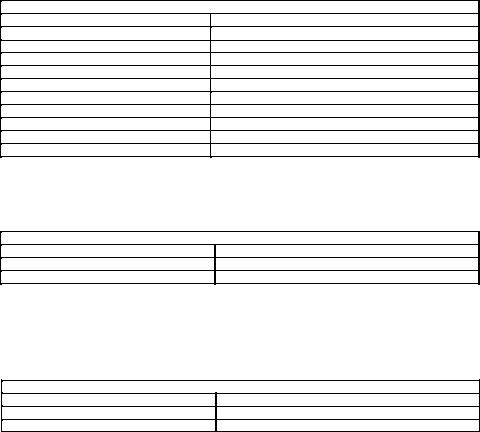
98 Diesner and Carley
of texts that contain links (for each sub-matrix) (Table 8) we see that the two tables are similar. In other words, many links appear in only one text. It is interesting to note which sub-matrices have more unique links than texts – e.g., the Agent-by-Knowledge and the Organization-by-Knowledge sub-matrices. This indicates that the texts that discuss the knowledge network tend to do so by discussing multiple linkages (e.g., all of these people know item z). Whereas texts that discuss, e.g., the social network (Agent-by-Agent) are more likely to simply talk about a single pair of actors and the nature of their relationship. Whether this pattern of reporting would hold in other cultures is debatable.
Beyond learning about the network structure of the meta-matrices and the distribution of concepts and connections between them across the sample data, analysts might be interested in investigating in more detail the concepts and links contained in the metamatrix. In order to gain this knowledge, sub-matrix text analysis5 can be run. For
Table 10: Who has what means? Organizational capability network (organization by resource)
Statements formed from Higher-Level Concepts (Sub-Matrix Analysis)
Sample text 1: |
Sample text 2: |
||
1 |
Al-Qaeda – training camp |
1 |
Al-Aksa - assets |
1 |
networkHawala |
1 |
Al-Aksa - money |
1 |
Hawala – money |
1 |
Hamas - sponsoring |
1 |
finance – network |
1 aid - Hamas |
|
1 |
camp - US-Government |
1 aid - Treasury Department |
|
|
|
1 money - Hamas |
|
|
|
1 support - Hamas |
|
|
|
1 |
Treasury - assistance |
|
|
1 |
US-Government - assistance |
|
|
1 assets - Treasury Department |
|
Table 11: Who knows what? Knowledge network (agent by knowledge)
Statements formed from Higher-Level Concepts (Sub-Matrix Analysis)
Sample text 1: |
Sample text 2: |
1 chairman – monitoring |
1 FBI - Analyst |
1 evidence – Saddam Hussein |
|
Table 12: Who is located where and does what? (Localized assignment network: agent by task-event by location)
Statements formed from Higher-Level Concepts (Sub-Matrix Analysis)
Sample text 1: |
Sample text 2: |
1 Saddam Hussein - Iraq |
1 arrest - Leader |
|
1 Leader - Germany |
Copyright © 2005, Idea Group Inc. Copying or distributing in print or electronic forms without written permission of Idea Group Inc. is prohibited.
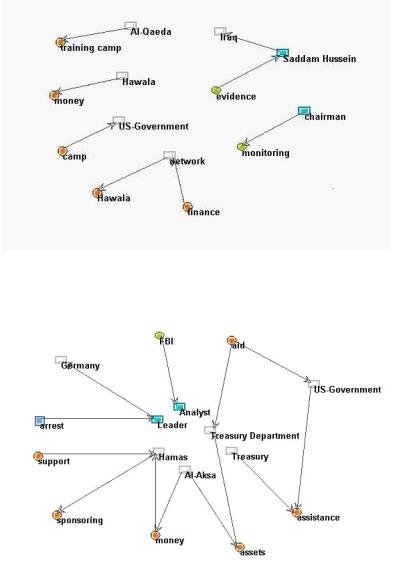
Revealing Social Structure from Texts 99
illustrating the results of this procedure, we show a map from the same text in Tables 10 to 12. A map contains one coded statement per line and its frequency.
These various sub-matrix networks enable a better understanding of what attributes of the meta-matrix link to other attributes, and with what strength. All three sub-matrices together enable a broader view of the situation. Figures 3 and 4 illustrate this broader picture. The comparison of figures 3 and 4 illustrates that text 1 presents a more disconnected story than does text 2. Further, even if the two stories were combined, the
Figure 3: Visualization of sub-matrices from sample text 1
Figure 4: Visualization of sub-matrices from sample text 2
Copyright © 2005, Idea Group Inc. Copying or distributing in print or electronic forms without written permission of Idea Group Inc. is prohibited.
